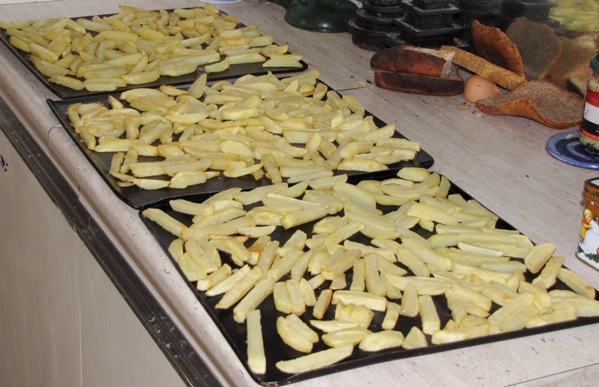A couple of weeks ago, I told you about my first attempts at lacto-fermentation, with a promise to tell you more in a few months. Well, um, it's not a few months yet, but here's an update anyway.
Both jars of veg bubbled away happily, with the courgettes being particularly vigorous. As the bubbles formed, of course they headed for the surface, and if there happened to be a piece of veg in the way, they tried to take that with them. Thus, veg that had been under the surface to start with headed out into fresh air. This is a common problem, and I'd read many suggested solutions for weighting the veg down, from clean rocks to smaller jars to bags of water. The only idea I could see that would fit through the neck of the jar and still hold down the veg at the edges was the plastic bag of water (or marbles), and I'm not terribly keen on leaving plastic in contact with the food for a long time.*
Without a weight, other alternatives include pushing the veg back down into the water from time to time, or leaving it well alone and relying on the carbon dioxide (formed by the fermentation) to exclude oxygen at the surface. With a simple, loosely-closed lid arrangement, I didn't have much confidence in the carbon dioxide staying put** so I went for the pushing-down option, aware that every time I did it I risked contaminating my ferment. The real reason was that I couldn't leave it alone!
Sure enough, a white film formed on the surface:

Beginnings of mould on the surface of fermented courgettes
People who use this basic method of fermentation are usually quite happy to scoop the mould off the top before taking out their pickled vegetables. I can go along with this - it's my usual approach to mould, in any case. I was a little concerned about the white substance appearing lower down in the jar, though. Surely mould couldn't be growing there?

Quite a lot of white stuff in there
Searching for information on this, I eventually found the Wild Fermentation forum (tip: Include Forum
in your search terms if you have a question like this) which assured me (and the questioner there) that this is fine - in fact it's a good sign. That white stuff is the bacteria we want in there (well, dead ones, anyway). So that's OK then.
I first tasted the courgettes at about three days after starting and they were definitely tangy, but a bit odd. Since I now have signs of mould, I've decided to eat up my courgettes (scooping off the white film every time) rather than leave the mould to grow. Now, at two weeks, the flavour is delicious, bit like pickled gherkins (I think - it's a long time since I tried any). The texture is good, too - quite firm, with a bit of a crunch. I'd read about this, but it was still surprising, especially as courgettes are a soft vegetable, and I'd squished them when I put them in the jar.
In spite of the mould, this is definitely a success. I'd like to persevere with this - now I just need a surplus of veg.
---
* I'm not paranoid about plastic and food, but I do bear in mind that some plastics degrade over time and that food-grade plastics are tested for safety in certain situations. For a plastic bag, this might or might not include sitting in a salty, acidic environment for several months. I don't know, so I'm wary. On the other hand, any potential harm caused by the plastic might be less bad than potential harm caused by the mould that it would have prevented. Again, I don't know.
** But I did come across instructions for improving on this arrangement, which I plan to try, so I'll tell you about that when I've done it.
















